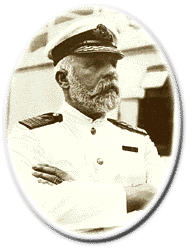 Titanic's
maiden voyage would be commanded by Edward J. Smith, a notable and
experienced captain, having over two million miles logged on White Star
liners. He was celebrated by both crew and passengers, and was even
called by some the "Millionaire's Captain." Smith was
transferred to Titanic from her sister Olympic, for what
he expected to be his final voyage before retirement. At sixty-two,
and twenty-six years with the White Star Line, Titanic's first
Atlantic crossing would be his last.
Titanic's
maiden voyage would be commanded by Edward J. Smith, a notable and
experienced captain, having over two million miles logged on White Star
liners. He was celebrated by both crew and passengers, and was even
called by some the "Millionaire's Captain." Smith was
transferred to Titanic from her sister Olympic, for what
he expected to be his final voyage before retirement. At sixty-two,
and twenty-six years with the White Star Line, Titanic's first
Atlantic crossing would be his last. Smith had great confidence in both his ships and his experience as captain. In response to questions about his career he assuredly remarked, "When anyone asks me how I can best describe my experiences of nearly forty years at sea, I merely say uneventful. I have never been in an accident of any sort worth speaking about....I never saw a wreck and have never been wrecked, nor was I ever in any predicament that threatened to end in disaster of any sort."

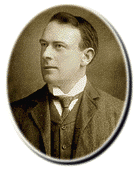 Also
on board for the maiden voyage were Bruce Ismay and Thomas Andrews, of The
White Star Line and Harland and Wolff, respectively. While Ismay's
interests were immediately that of the White Star Line, Andrews' concerns
were directed more toward the Titanic herself. He
scrutinized and noted final details that needed to be corrected, including
such minute details as the number of screws in clothes hooks. Both
Ismay and Andrews traveled among the First Class in private staterooms.
Also
on board for the maiden voyage were Bruce Ismay and Thomas Andrews, of The
White Star Line and Harland and Wolff, respectively. While Ismay's
interests were immediately that of the White Star Line, Andrews' concerns
were directed more toward the Titanic herself. He
scrutinized and noted final details that needed to be corrected, including
such minute details as the number of screws in clothes hooks. Both
Ismay and Andrews traveled among the First Class in private staterooms.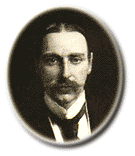
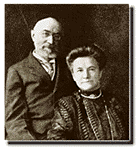 Titanic
also carried a number of the wealthiest people in the world.
First Class passengers included Colonel John Jacob Astor and his wife,
returning from a European voyage; Isidor Straus, a director of the famous
Macy's department store, who with his wife Ida, had been traveling in the
south of France; George Widener, one of the richest people in
Philadelphia, Pennsylvania, along with his wife Eleanor and son Harry;
William Stead, author and editor of the periodical Review of Reviews;
and the distinguished industrialist Benjamin Guggenheim.
Titanic
also carried a number of the wealthiest people in the world.
First Class passengers included Colonel John Jacob Astor and his wife,
returning from a European voyage; Isidor Straus, a director of the famous
Macy's department store, who with his wife Ida, had been traveling in the
south of France; George Widener, one of the richest people in
Philadelphia, Pennsylvania, along with his wife Eleanor and son Harry;
William Stead, author and editor of the periodical Review of Reviews;
and the distinguished industrialist Benjamin Guggenheim.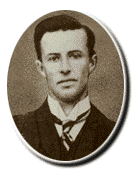
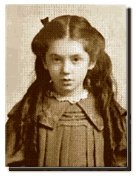 Second
Class passengers included the British school teacher Lawrence Beesley, who
would later write a telling account of the events surrounding Titanic's
sinking. Beesley kept attentive mental and written notes during the
voyage. Also in Second Class were Benjamin and Esther Hart, along
with their daughter, Eva. Mrs. Hart however was quite uneasy about having
to travel on the Titanic. So strong was her premonition of
misfortune that she refused to sleep during the night. Had she been
sleeping when Titanic struck an iceberg, she likely would not
have noticed the slight bumping it caused on impact.
Second
Class passengers included the British school teacher Lawrence Beesley, who
would later write a telling account of the events surrounding Titanic's
sinking. Beesley kept attentive mental and written notes during the
voyage. Also in Second Class were Benjamin and Esther Hart, along
with their daughter, Eva. Mrs. Hart however was quite uneasy about having
to travel on the Titanic. So strong was her premonition of
misfortune that she refused to sleep during the night. Had she been
sleeping when Titanic struck an iceberg, she likely would not
have noticed the slight bumping it caused on impact.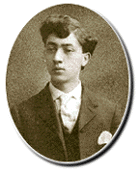
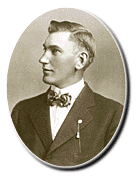 Third
Class passengers, also known as "steerage," made up the largest
portion of any single class on Titanic. One Third Class
passenger was Henry Sutehall of Kenmore, New York. He had travelled
with a friend across the United States, then to Australia and eventually
back to England before finally booking passage on Titanic.
He was returning home after a worldwide voyage of nearly two years.
Swedish passenger Carl Jansson was also in Third Class. As he
prepared to come up on deck after collision with the iceberg, he noticed
that water was sloshing around his feet before eventually reaching his
ankles.
Third
Class passengers, also known as "steerage," made up the largest
portion of any single class on Titanic. One Third Class
passenger was Henry Sutehall of Kenmore, New York. He had travelled
with a friend across the United States, then to Australia and eventually
back to England before finally booking passage on Titanic.
He was returning home after a worldwide voyage of nearly two years.
Swedish passenger Carl Jansson was also in Third Class. As he
prepared to come up on deck after collision with the iceberg, he noticed
that water was sloshing around his feet before eventually reaching his
ankles.